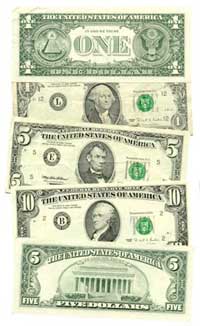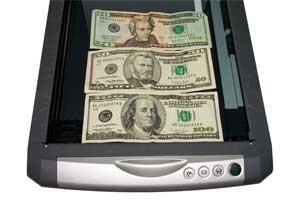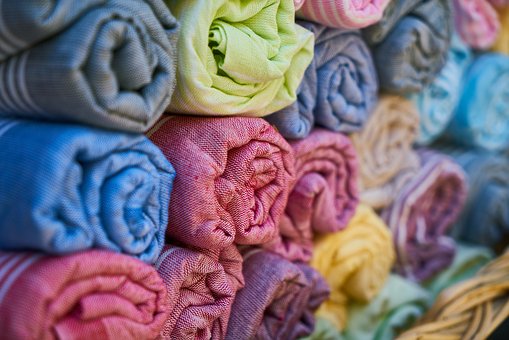Counterfeiting involves the creation of fake money, and it is the government’s job to stay one step ahead of these counterfeiters. While ingenuity and skill were the main factors leading to successful counterfeiting in the past, recent improvements in digital scanners and printers have made counterfeiting much easier. In order to battle these new technologies, the American government has begun to add new anti-counterfeiting devices to America’s money, such as security strips and watermarks. The government is also implementing new features in the digital equipment used to make the counterfeit bills. Digital copiers and printers recognize bills and prevent them from being copied. Paralleling the changes in currency technology, counterfeiters have changed demographics. Teenagers have recently become heavily involved in counterfeiting thanks to the ease with which bills can be made. It is a daunting task, but the treasury strives to stay advanced enough to thwart this ever present enemy.
Taking Cash for Granted
Imagine you’ve just spent a delightful evening dining at your favorite restaurant with a special someone. The bill comes out a little more than you expected, but who cares? A nice night on the town is priceless, right? Good thing you brought some money with you. After struggling a little, you place a staggeringly heavy three-hundred pound, granite donut next to the table, toss in a few small rock rings as tip, and leave with your date. As peculiar as this scene may seem, the inhabitants of Yap, a small island in the south pacific, still conduct business transactions with such stones. Called Rai, these stones are inconvenient to use and hard to get, as islanders harvest them from an island 250 miles away [1]. Why would a culture have Rai as currency? The giant stones are incredibly hard to counterfeit. Fake stone rings are just as difficult to manufacture as the real thing is to quarry. Besides, the islanders place value on the effort needed to harvest these rocks, not just on the objects themselves.
In contrast, our dollars do not require such intensive labor to create, and therefore are easier to replicate (see Fig. 1). In the past, quality counterfeiting required vast amounts of skill and precision, but modern day technologies allow even the clumsiest of crooks to play the part of Rumpelstiltskin and turn paper into gold.
A Brief History of Currency and Counterfeiting
Money’s origins can be traced back to the ancient civilization of Mesopotamia. Before using currency, Mesopotamians bartered or used certificates of ownership to perform business transactions. Five different tokens were used as trading materials [2]. Citizens traded these tokens with each other, and then redeemed the tokens for their specified values at a later time. With the development of cities, more products were readily available, requiring salesmen to carry up to 16 types of tokens for proper trading. Bartering with such a variety of tokens presented problems as traders only knew of an object’s worth relative to other objects. For example, a pound of cheese was worth one half a pound of goat meat, or three pounds of grain, or sixteen strands of rope. The solution to this complex system lay in the standardization of currency. Small weights of silver replaced the token system, as people used them solely for trade. Higher class Mesopotamian citizens used coils of silver, which had distinct weights and dimensions, for their more expensive purchases [2]. These coils would set the stage for all of western civilization’s future forms of currency.
Coins, although still in existence, are no longer the primary form of currency. Bills, or money printed on paper, have taken over as a far more practical form. Their construction makes them easy to carry and cheap to manufacture. The ease with which governments manufacture bills, however, also makes the paper bills easy to counterfeit. Counterfeiting of bills began early, with forgers taking the time to hand engrave templates and set up printing presses, although time has made counterfeiting much easier.
The Greenback: America’s First Attack on Counterfeiting
Prior to the 1863 creation of a national currency, banks throughout the United States distributed over 7000 different bills. With so many bills in circulation, shop owners, especially illiterate ones, could not familiarize themselves with all the circulating bills. Counterfeiters prospered with relative ease. By the time the U.S. adopted a national currency, counterfeits made up an estimated one-third of the bills in circulation [3].
To counteract the problem, the United States Federal Reserve produced bills known as “greenbacks” that had multiple anti-counterfeiting features. Cameras at the time produced only black and white photos and therefore were unable to replicate the bills’ green color [4]. Other security features built into the dollar involved its paper, ink, and printing process. Rag paper, or paper constructed from fabric fibers, was chosen for the bills thanks to its durability and relatively high cost of construction (to discourage counterfeiters from manufacturing it). Advanced mills formed the paper by using high pressure and temperature. The equipment, therefore, was expensive to purchase and run. The ink used in the process contained high concentrations of iron, giving it magnetic properties not found in other standard inks. Finally, intaglio presses chosen to produce the greenbacks differed from other printing techniques because ink rested in the grooves of the press, as opposed to lying on elevations. The ink was then transferred onto the paper without direct contact through the application of high pressures. For these reasons, only experienced printers could produce crisp images with intaglio presses [4].
Counterfeiters Find a New Workplace
Very little has changed in America’s currency since the greenbacks’ introduction. Our money still has a distinctive green color, the paper is still composed of linen and cotton, and the presses are still lined with intaglio plates. However, advances in photo and digital imaging allowed counterfeiters to bypass many of the security features of our nation’s money through photocopying (see Fig. 2).
In 1993, the National Treasury formed a commission to determine the impact of such new technologies on counterfeiting. Their research showed that production of photocopied bills accounted for only four percent of detected fakes, but the number of bills detected had doubled in a single year. Over the next seven years the number of photocopied fakes would increase to 60% of all confiscated fraudulent bills [4]. In order to counteract this newly available technology, the Bureau of Printing and Engraving (BPE) developed and implemented several advanced modifications to the $100 bill (the most counterfeited bill at the time). In 1996, microprinting and plastic security strips were implemented as a defense against photocopying. Microprinting that appeared around Benjamin Franklin’s portrait, while visible through a magnifying glass, was too finely drawn for machines at the time and appeared blurry on printed counterfeits [3]. Bills printed by photocopiers also could not reproduce the plastic security strips.
Photocopiers and digital photo manipulation have come a long way since 1993. The resolutions of these machines have increased ten fold. In printing, the term DPI, dots per inch, informs consumers of the printer’s resolution. Printers with large DPI ratings can easily reproduce crisp clean images of Washingtons, Franklins, and Lincolns with the touch of a button. This technology allows counterfeiters to bypass the deterrents implemented by the BPE in 1996 (see Fig. 3).
In an attempt to regain control over counterfeiting, the BPE declared that all bills in circulation would use more advanced anti-counterfeiting features within the next twenty years. With an emphasis against photocopying, new bills contain an array of features including watermarks and color-changing ink. Watermarks are images visible only through transmitted light, meaning they are visible only when bills are held up to a light source. During printing, presses crush segments of paper causing a difference in the thickness of paper. Thinner segments of paper let more light through and the combination of thicknesses allows for the creation of an image [4]. Color-changing ink, which appears green, gold, or black depending on the angle at which it is viewed, is the result of a unique matrix of micropigments. The alignment of pigmentation on a molecular level creates differences in reflected light from different angles. Both features are extremely difficult to properly replicate using simple desktop computers. Although they can be mimicked by a master of photo editing software, reproductions created by computers lack the dynamic properties of these new bills.
While the Bureau of Printing and Engraving changes the nature of our bills, federal laws are changing the nature of our printers and scanners. The federal government is putting pressure on companies of photocopying machines to create devices that help deter counterfeiting. Such techniques consist of digital watermarking and currency detection software. Digital watermarks are information discretely inserted into digital copies. One example of a digital watermark is printer serial codes, which are small yellow dots printed on every copy a printer makes. These small yellow dots are not easily seen by an unaware bystander, but when held under the scrutinizing eye of a Secret Service agent, they then can lead to the source of counterfeit bills [3]. Currency-detection software allows for scanners and printers to recognize attempts at printing or scanning money. Scanners with this software automatically delete any incoming scans that resemble currency, preventing counterfeiters from creating a digital copy.
The New Face of Counterfeiters
Older counterfeiting techniques required years of printing expertise and hours of labor. However, today’s technologies have drastically reduced the need for experience, time, and money. A new demographic is taking advantage of this simple process: teenagers.
It took Dustin Hardy, a 17 year old from New Mexico, less than a day to hone his craft of counterfeiting. After a few failed attempts, over $200 worth of counterfeit bills lay in Hardy’s hands. Although his amateur bills quickly raised eyebrows and resulted in his arrest by federal agents, their production is a perfect example of the ease with which our money can be replicated. Since cumbersome printing presses are no longer needed, less experienced counterfeiters can produce bills and then dispose of incriminating equipment [5]. The counterfeiting mills of today are both portable and disposable, making counterfeiters hard to track down and punish.
Made in the USA?
With so many cheap ways to make a bill, one forgets about counterfeiting the old fashioned way: with intaglio presses, high tech inks, and rag paper. Although this approach requires vast amounts of capital and skill, some nations happen to have both. Believe it or not, counterfeit bills are being produced overseas by foreign governments. These “supernotes” are virtually identical to their authentic counterparts and have been pouring into American and foreign markets at alarming rates. Last year alone, the Secret Service detected over $24,500,000 worth of these bills [6]. The amount of counterfeits that go undetected, however, is open to speculation.
Keeping Benjamin Safe
The task of stopping professional counterfeiters, teenagers, and countries from copying our bills seems daunting, but certain measures could easily be enacted that would halt counterfeiters in their tracks. The development of serial algorithms on our bills would make counterfeiting virtually impossible. An example of such an algorithm would be a set of corresponding numbers and barcodes placed on every bill. The numbers on the front of the bill only match the barcode on the back of that specific bill. Machines would read both sides of the bill to validate its authenticity. However, this process could reduce the freedom that cash offers. This technology would enable easy tracking of a bill throughout its lifetime, giving the government information about cash sales, purchases, and possibly even the identities of the money’s users [3].
Another factor to consider in the making of currency is the price of ensuring a bill’s validity. Currently, bills cost 4.3 cents to produce. Advanced features such as the ones mentioned above could quadruple that cost. With an average lifetime of only 18 months for a one dollar bill (this number is larger for other bills due to their limited usage) a more expensive dollar could set our economy back. An estimated 318 million dollars is lost every year just by replacing worn bills [4].
Producing bills that are secure, durable, and cheap is no easy matter. Engineers have risen to the occasion before, and will continue to produce new bills spoiling the efforts of counterfeiters for years to come. So next time you open your wallet and see a long dead president smiling at you, realize it’s because he knows he’s in safe hands.<
For the Record
The article “Making a Quick Buck: Counterfeiting in America”, originally published in Illumin Volume X, Issue III, incorrectly cited two facts from a Wired article used as a source. First, the amount of counterfeit money printed by Dustin Hardy was $224, not “over $300.” Second, there is no indication of any court appearance by Mr. Hardy. The new version is posted.






